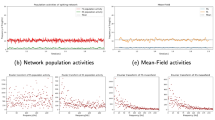Abstract.
A simple hypothesis regarding the recognition behaviour of crickets for conspecific songs is implemented in a dynamic simulation of spiking neurons and tested on a robot base. The model draws on data from cricket neurophysiology but requires only four neurons to reproduce a wide range of the observed behaviour. The directional response depends on relative latencies in firing onset, and the `recognition' emerges from the implicit filtering properties of leaky-integrate-and-fire neurons. Experimental conditions reproduced include tests of syllable rate preference, song from above with sound from one side, and choice between songs. The robot produces behaviour closely comparable to the cricket in all but a `split-song' condition. A number of properties can be observed in the neural circuit that correspond to cricket neurophysiology including apparent `recognition neurons'. Limitations of the model, extensions and alternative models are discussed.
Similar content being viewed by others
Author information
Authors and Affiliations
Additional information
Received: 14 July 1997 / Accepted in revised form: 7 September 1999
Rights and permissions
About this article
Cite this article
Webb, B., Scutt, T. A simple latency-dependent spiking-neuron model of cricket phonotaxis. Biol Cybern 82, 247–269 (2000). https://doi.org/10.1007/s004220050024
Issue Date:
DOI: https://doi.org/10.1007/s004220050024




